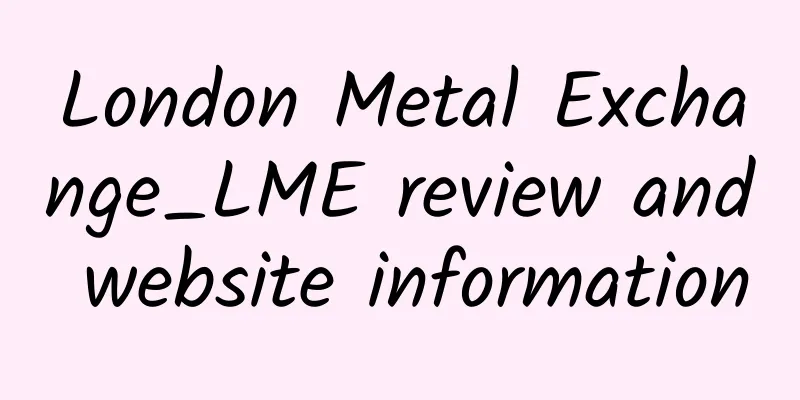London Metal Exchange_LME review and website information

|
London Metal Exchange_What is LME? London Metal Exchange (LME) is the world's largest base metal exchange. It was established in 1877 and its trading products include copper, aluminum, lead, zinc, etc. It was acquired by Hong Kong Exchanges and Clearing Limited in 2012. Website: www.lme.com London Metal Exchange (LME): The core hub of global base metal tradingThe London Metal Exchange (LME) is the world's largest base metal futures and options market and has been the center of international metal trading since its establishment in 1877. As an exchange with a long history and global influence, LME not only provides a price discovery mechanism for the metal industry, but also supports the stable operation of the global supply chain through its unique trading model and wide range of products. The official website of LME is located at www.lme.com , which is a comprehensive information platform covering a wide range of content from market data, product introduction to member services, etc. Both industry professionals and ordinary investors can obtain the latest market trends and detailed information resources through this website. Historical Background and Important MilestonesThe history of the London Metal Exchange can be traced back to the mid-19th century, when Britain, as the birthplace of the Industrial Revolution, saw a surge in demand for metals. To meet this demand, merchants began trading metals in coffee houses in London. By 1877, these transactions were gradually standardized and the London Metal Exchange was officially established. Initially, LME only offered copper trading, but as market demand grew, other metals such as aluminum, lead, and zinc were also gradually included in the trading range. In 2012, LME reached an important turning point when it was acquired by Hong Kong Exchanges and Clearing Limited (HKEX). This acquisition not only expanded LME's global influence, but also brought it closer to the Asian market, further consolidating its position as a global base metal trading platform. Today, LME has become a key bridge connecting producers, consumers and investors around the world. LME's core functions and featuresThe main function of LME is to provide price discovery and risk management tools for the global metals industry. The following are some of the core features of LME:
In addition, LME is unique in its "Ring Trading" model. This trading method allows members to trade face-to-face during fixed trading hours, and although modern electronic trading systems have become dominant, Ring Trading still retains some of its traditional charm. Main trading products and contractsLME offers a wide variety of trading products, covering almost all major base metals. The following are several key products and their corresponding contracts: copperCopper is one of the earliest trading products launched by LME and one of the metals with the largest trading volume. Copper is widely used in electricity, construction and manufacturing due to its good conductivity and corrosion resistance. LME's copper contracts include three-month copper contracts and spot copper contracts, among which the three-month copper contract is the most popular. aluminumAluminum is known for its lightness and high strength and is widely used in aerospace, automobile manufacturing and packaging. LME's aluminum contracts are also divided into spot and futures, with a trading unit of 25 tons. Lead and zincLead is used in battery production, while zinc is often used in the anti-corrosion coating of galvanized steel. Contracts for both metals are also very active on the LME, reflecting their importance in the global economy. Nickel and tinNickel is a high-temperature and corrosion-resistant metal widely used in stainless steel production and alloy manufacturing. Tin is mainly used in electronic welding materials. LME provides standardized futures contracts for these two metals to help companies better manage the risk of price fluctuations. Emerging Metals: Cobalt and LithiumWith the development of new energy industry, the importance of cobalt and lithium has become increasingly prominent. Cobalt is an important component of lithium batteries, while lithium itself is the core raw material of electric vehicle batteries. LME has launched relevant contracts in recent years to adapt to the market demand for these emerging metals. How LME worksLME's operating mechanism combines the advantages of traditional and modern technologies, mainly including the following trading methods:
In addition, LME also has a huge global warehousing network to ensure that the physical delivery of transactions can be carried out smoothly. These warehouses are located in many regions around the world, storing a large amount of metal inventory, providing sufficient liquidity to the market. LME's role in the global supply chainAs the core platform of the global metal industry, LME plays a vital role in the supply chain. First, it provides producers with a channel to sell their products, while also providing consumers with an opportunity to purchase metals. Second, LME's price benchmark helps companies and governments make reasonable policy and strategic decisions. For example, mining companies can lock in future sales revenue through LME futures contracts, while manufacturers can use the same tool to reduce uncertainty in raw material costs. This two-way risk management mechanism makes the entire supply chain more robust. Challenges and Future ProspectsDespite its dominant position in the global metals market, the LME also faces some challenges. The first is competition from other exchanges, such as the Chicago Mercantile Exchange (CME) and the Shanghai Futures Exchange (SHFE), which are also expanding their influence in metal trading. The second is the pressure of digital transformation, which requires the LME to continuously optimize its electronic trading system to meet the needs of the modern market. In the face of these challenges, LME is taking positive measures. On the one hand, it continues to expand its product line and introduce more emerging metals trading; on the other hand, LME is also strengthening its ties with the Asian market, especially in China, the world's largest metal consumer. Looking ahead, LME will continue to work to promote the sustainable development of the metal industry. For example, it plans to launch more green metal contracts to encourage companies to adopt environmentally friendly production processes. At the same time, LME is also exploring the application of blockchain technology to improve the transparency and efficiency of transactions. SummarizeThe London Metal Exchange (LME) is not only the core platform for global metal trading, but also a key link between producers, consumers and investors. From its long history to its modern trading mechanism, the LME has always been at the forefront of industry development. Through continuous innovation and adaptation to market demand, the LME will continue to play an important role in the global metal market. If you want to know more about LME, please visit its official website: www.lme.com . Here, you can not only find detailed market data and analysis reports, but also learn about the latest industry dynamics and development trends. |
<<: How is the French DCNS Group? French DCNS Group reviews and website information
>>: What is HMD Global like? HMD Global review and website information
Recommend
The efficacy and effects of fresh dendrobium and the benefits of eating fresh dendrobium
Fresh Dendrobium is the most common natural healt...
How to make wine How to make wine correctly
In life, many people like to make wine at home wh...
Pujin porridge
I believe many friends are not very clear about s...
What fruits can supplement iron? What fruits are good for iron deficiency?
Iron deficiency will cause ischemia. Iron is an i...
Therapeutic and health benefits of common vegetable juices
Nowadays, people like to drink some fresh vegetab...
How is the Chinese Consulate General in Rio de Janeiro? Reviews and website information of the Chinese Consulate General in Rio de Janeiro
What is the website of the Consulate General of Ch...
What is the Economic Community of Central African States? Economic Community of Central African States reviews and website information
What is the website of Economic Community of Centr...
How to pickle carrots
I believe there are still many friends who don’t ...
What should I avoid eating when my blood sugar is high? Dietary taboos for high blood sugar
High blood sugar is a common adverse symptom in h...
How to make monk fruit tea How to make monk fruit tea
Modern people pay attention to health preservatio...
Sour plum
Everyone knows that plums are delicious fruits, b...
How is the Philippine Star? Philippine Star reviews and website information
What is the Philippine Star website? The Philippin...
The efficacy and effects of boiling loquat leaves in water Taboos of drinking boiling loquat leaves in water
Loquat leaves are the leaves of the loquat plant....
Balcony Spinach Planting Methods and Techniques
Nowadays, many people fill their balconies with s...
What is Great Wall wine like? How to drink Great Wall wine
Great Wall Wine is a fine domestic wine, a famous...









